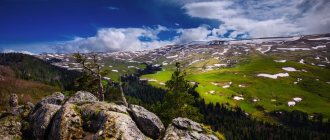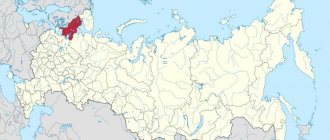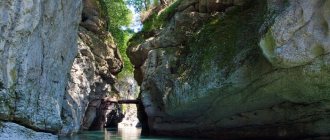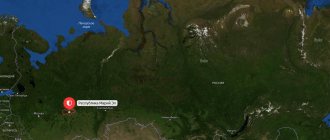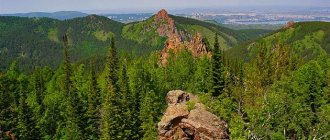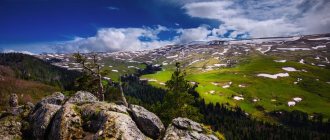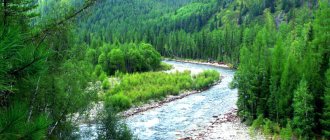| Republic of Adygea |
The Republic of Adygea
, part of the Southern Federal District of Russia, is part of the North Caucasus economic region. The capital is Maykop. It is located in the south of the European part, in the northwestern part of the Caucasus, the northern part is on the Kuban Plain, and the southern part is on the slopes of the Greater Caucasus. The territory of the republic is surrounded on all sides by the territory of the Krasnodar Territory. Territory area 7.8 thousand square meters. km, population 453.4 thousand people. (2018)
- On the map: Yandex.Map, Google map
The Adygs as a people with a single language and culture emerged by the 10th century; they occupied the territory from the Taman Peninsula to Abkhazia and to the Azov region and the Kuban River.
The self-name “Adyghe” presumably reflects the name of the Zikhi tribe through the intermediate form a-dzyge - this is confirmed by the Abkhaz name of the Adygs, Azykhu, and the Georgian name, Dzhiki. Zikhi are mentioned in the “Geography” (Book XII) of Strabo (18 BC), later found in the works of Greek and Latin authors, in Byzantine sources of the 6th-10th centuries, disappearing from literature from the 13th century, when new ones appeared The names of the Circassians are Kasogs, Circassians. Subsequently, the formation and isolation of ethnic groups continued. In the 16th-18th centuries, wars against the Circassians were waged by the Ottoman Empire and the Crimean Khanate, which forced them to seek the protection of the Russian state. In 1552-1557, several Adyghe embassies arrived in Moscow. The chronicles are the only sources by which one can judge the details of the Russian-Adyghe negotiations. It was about protection from the attacks of the Crimean Tatars. Connections between the Circassians and Russia were established through the Nogai rulers, who were oriented toward Rus'. The appeal of the Circassians to Moscow did not mean their immediate entry into Russia. The inclusion of the Circassians in the Russian administrative-political system began only after the end of the Caucasian War (1817-1864).
The Adygs lived in separate large tribes or tribal unions. Each tribe occupied its own territory and had different customs. Historically, there was a continuous process of consolidation of tribes into a single nation. Sources from the 10th century mention three large tribal associations: Zikhia, Papagia and Kasakhia. In the 16th-17th centuries, unsuccessful attempts were made to unite the Circassians into a single state. The 18th century was marked by widespread colonization of the North. Caucasus by Russian and Ukrainian settlers. Circassia was one of the theaters of the Russian-Turkish wars of 1787-1791 and 1806-1812. In difficult conditions of confrontation between powers pursuing an expansionist policy, the Circassians waged an armed war for their independence. According to the Iasi (1791) and Bucharest (1812) peace treaties concluded between Russia and Turkey, Circassia was under the control of the Ottoman Empire. At the same time, the Russian Empire did not abandon its interests in this region, pursuing its policy through both economic and military means.
As a result of the Russian-Caucasian War of 1817-1864, most of the Circassians became muhajirs, moving within the Ottoman Empire. The rest were settled on flat lands on the left bank of the Kuban.
After the October Revolution of 1917, the territory of Adygea from May 1918 was part of the Kuban-Black Sea Soviet Republic.
On July 27, 1922, the Adygea (Circassian) Autonomous Region
on the territory of the Maykop and Yekaterinodar departments of the Kuban-Black Sea region, whose authorities were located in the city of Krasnodar.
On August 13, 1928, it was renamed the Adygea Autonomous Region
.
From August 2, 1924 to December 28, 1934, the region was part of the North Caucasus Territory, then until September 13, 1937 it was part of the Azov-Black Sea Territory, then it became part of the Krasnodar Territory.
On April 10, 1936, the center of the region was moved to the city of Maykop, which was included in the Adygea Autonomous Region.
On April 28, 1962, the Tula (now Maikop) district was transferred to the region from the Krasnodar Territory.
On December 15, 1990, the Adygea Autonomous Region seceded from the Krasnodar Territory.
On July 3, 1991, the autonomous region was transformed into the Republic of Adygea.
On March 10, 1995, the Legislative Assembly (Khase) approved the Constitution of the Republic of Adygea.
The Republic of Adygea consists of seven districts and two cities of republican subordination, Adygeisk and Maykop.
Story
Main article: History of Adygea
Until 1991, it was not a separate republic; the territory was part of the Krasnodar Territory. In December 1991 - January 1992, elections of deputies to the Supreme Council of the Republic of Adygea took place. The first parliament in the history of Adygea was formed. In 1993, it was transformed into the Legislative Assembly (Hase), and in 1995 into the State Council - Hase.
In January 1992, the first president of the republic, Aslan Dzharimov, was elected, and in March 1992, the first chairman of the Supreme Council of the Republic of Adygea, Adam Tleuzh. From 2007 to 2007, Adygea was headed by Khazret Sovmen, from 2007 to 2022 by Aslan Tkhakushinov. Since 2017, the Head of the Republic of Adygea is Murat Kumpilov.
On December 25, 1993, the Constitution of the Russian Federation, which came into force, confirmed the republican status of Adygea.
The Constitution of the Republic of Adygea was approved by the Legislative Assembly (Khase) on March 10, 1995.
Administrative division
Main article: Administrative-territorial division of Adygea
Modern administrative-territorial division of Adygea
According to the Law of the Republic of Adygea “On the administrative-territorial structure of the Republic of Adygea”, the republic includes administrative-territorial units: 7 districts and 2 republican city districts (2 cities of republican significance with subordinate settlements):
- 1. Maykop Republican Urban District,
- 2. Adyghe Republican Urban District,
- 3. Giaginsky district,
- 4. Koshekhablsky district,
- 5. Krasnogvardeisky district,
- 6. Maykop district,
- 7. Takhtamukay district,
- 8. Teuchezhsky district,
- 9. Shovgenovsky district.
They, in turn, also include settlements related to the administrative-territorial units of Adygea:
- urban settlements:
- rural settlements:
Within the framework of the municipal structure of the republic, 60 municipalities have been created within the boundaries of the administrative-territorial units of Adygea, among which the following stand out:
- 2 urban districts,
- 7 municipal districts, including 48 rural settlements,
- 3 urban settlements.
| № | Coat of arms | Name | Administrative center | Area, km² | Population, people |
| Cities of republican significance (republican urban districts) | |||||
| 1 | Maykop | Maykop | 57 | 164 575 | |
| 2 | Adygeisk | Adygeisk | 31,5 | 15 133 | |
| Districts (municipal areas) | |||||
| 3 | Giaginsky district | Giaginskaya village | 790 | 31 971 | |
| 4 | Koshekhablsky district | aul Koshekhabl | 606 | 29 569 | |
| 5 | Krasnogvardeisky district | Krasnogvardeyskoe village | 726 | 32 125 | |
| 6 | Maykop district | Tula village | 3667 | 61 104 | |
| 7 | Takhtamukay district | village Takhtamukai | 440 | 92 035 | |
| 8 | Teuchezhsky district | aul Ponezhukay | 710 | 20 396 | |
| 9 | Shovgenovsky district | village Khakurinokhabl | 521 | 16 180 |
Population
In 1999, the population of Adygea was 449.3 thousand people, of which 95.4 thousand were Adygeis (Adygs), self-name - Adyge (Old Russian Kasogi, Old Circassians), local ethnographic and dialect differences remain: Abadzekhs, Bzhedugs , Shapsugs, Besleneyevtsy, Zhaneevtsy, Natukhaytsy, Temirgoyevtsy, Khatukayevtsy, Egerukayevtsy, Mamkheg, Makhoshevtsy, Khakuchi. Currently, Adygea is inhabited mainly by four subethnic groups - Abadzekhs, Bzhedugs, Shapsugs, Temirgoys, representatives of other groups are settled among these subethnic groups. The republic is also home to Russians - 293.6 thousand, Ukrainians - 13.8 thousand, Armenians - 10.5 thousand, Belarusians - 2.7 thousand, Tatars - 2.7 thousand, Germans - 1.8 thousand ., Greeks - 1.6 thousand, Gypsies - 1.1 thousand.
Western Adygs (inhabiting Adygea) speak the Adyghe language (four dialects), which belongs to the Adyghe group of Western Caucasian languages. The official languages are Russian and Adyghe.
Economy
The main economic sectors of the region are industry, agriculture, tourism and trade.
Industry
Industry is one of the basic sectors of the region's economy.
Industrial enterprises in the region are represented by 7 industries. In the structure of industrial production, the largest share belongs to manufacturing industries - 80.4% in the total volume of shipped industrial products ( of which: food production - 26.4%; production of other non-metallic products - 37.2%; production of wood products - 16 .7%
), followed by mining - 16.0%, production and distribution of electricity, gas and water - 2.7% and less than 1% in the structure of shipped industrial products is occupied by forestry.
Agriculture
In the region, agricultural activities are carried out by 18 agricultural enterprises, 118 peasant farms ( of which: 65 in the field of crop production and 53 in the field of livestock production
), as well as 112 individual entrepreneurs.
The world's northernmost tea-growing farm is located in the Maykop region. Tea processing is carried out at the Adyghe branch of the All-Russian Research Institute of Floriculture and Subtropical Crops in the village of Tsvetochny.
Tourism
The Maykop region is one of the main year-round resorts in the North-West Caucasus and is the main tourist center of the republic, with great natural and tourist potential.
The following areas have received the greatest development in the region: sports tourism, ecotourism, hiking tourism, water tourism, mountain tourism, mountaineering, auto tourism, ethnotourism, as well as pilgrimage to places of worship. One of the most significant investment projects in the tourism sector of the region and the republic as a whole is the “Lago-Naki Gates” Tourist and Recreational Cluster, which provides for the construction of interconnected tourist and excursion facilities.
Science, education and culture
Main article: Adyghe literature
Main article: Adyghe studies
The oldest cultural monument of the Adyghe ethnic group is the Nart epic, which reflects the Adyghes’ ideas about the world at the early stage of the development of human society, their occupations, ethical standards and philosophical ideas, legends, features of life and morals.
There are two universities in the republic:
- Adyghe State University, former Adyghe Pedagogical Institute (ASU)
- Maikop State Technological University (MSTU)
Secondary specialized educational institutions operate:
- Adyghe Pedagogical College named after. Kh. Andrukhaeva,
- Adyghe Republican College of Arts named after. U. Kh. Thabisimova,
- Maikop Medical College (MMK).
- Maikop State Humanitarian and Technical College at the Adyghe State University (MGGTK ASU),
- Polytechnic College at MSTU,
- professional lyceum No. 6.
Subdivisions (branches, departments) of Russian universities are open and operating in the republic:
- Adyghe branch of the North Caucasus Academy of Public Administration in Maykop,
- Maikop branch of the Modern Humanitarian Academy,
- Adyghe branch of the Moscow Open Social Academy (MOSA),
- Adyghe branch of the South Russian State Technical University (Novocherkassk Polytechnic Institute),
- Adyghe branch of Kuban State Medical University,
- Adyghe branch of the Russian State Social University.
Valid
- Adyghe Republican Institute for Advanced Studies,
- Adyghe Research Institute of Agriculture,
- Adyghe Republican Institute of Humanitarian Studies named after T. M. Kerashev.
There are 8 state and 23 public museums in Adygea.
The National Museum of the Republic of Adygea has unique archaeological, ethnographic, and natural collections. A special department of the Adyghe diaspora was opened, the clear result of which was a significant replenishment of the museum’s funds with exhibits from the period of the Caucasian War (1817-1864) and the life of the Adygs abroad.
There is a branch of the State Museum of Oriental Art in Maykop.
In the Republic of Adygea there are 370 units of state institutions of culture and art, including: 153 institutions make up a library network, 130 club establishments, 35 cinemas and film installations, 23 educational institutions, 8 museums, 6 theater and concert organizations, 1 art gallery, inspection protection of historical and cultural monuments, etc.
Religion
The majority of the population of Adygea is Orthodox, about a quarter of the population are Sunni Muslims of the Hanafi persuasion, a small number are Catholics and adherents of other religions. There are 16 Islamic organizations, an Old Believer community, the Armenian Church of the Holy Resurrection, three Baptist communities and a Seventh-day Adventist community operating on the territory of the republic.
Russian Orthodox Church
In 1829, the Don Diocese was formed, which included the territory of Adygea. From April 4, 1842, Adygea was within the newly established Caucasian and Black Sea (Stavropol) diocese.
Since 1919, by decree of the Provisional Church Administration in the South-East of Russia, an independent Kuban diocese was formed. In the 1920s, the Maykop Vicariate of the Kuban Diocese was established.
On March 28, 1991, the Maykop deanery of the Krasnodar diocese was created with its center in Maykop.
On February 26, 1994, an independent Maykop diocese was established on the territory of the Republic of Adygea and thirteen districts of the Krasnodar Territory. On December 28, 2000, parishes located within the Krasnodar Territory were separated from the diocese.
As of March 2022, there are 59 parishes and one monastery of the Russian Orthodox Church in the Republic of Adygea [1].
Paganism
The pagan beliefs of the Circassians existed for a long time. The deities that the Circassians worshiped were the great god Thyeshkho, the god of the soul Psathye, the god of thunder Shyble, the god of fertility Thyegeledzh, the god of the forest and patron of hunters Mazytkhye, etc. Among the Circassians, relics of pagan beliefs are preserved.
Spread of Christianity
The spread of Christianity among the Circassians was associated with the policy of Byzantium in the Caucasus. The information about the presence of the bishop dates back to the century. Damian of Zikh at the Council of Constantinople in 526, although there is an opinion about an earlier (1st century) spread of Christianity in the region from the Black Sea to Dagestan [2]. According to researcher E. Kh. Panesh, in the 7th century there was a flourishing of Christianity among the Circassians. Christianity came through the Greek. Black Sea colonies, as well as through the neighbors of the Circassians, Christian Abazgia. For at least a century, the Phanagorian See existed: its bishop is listed among those present at the First Ecumenical Council; it is not mentioned further. In the 8th century, the spread of Christianity among the Circassians in the coastal regions continued. An archdiocese was founded in the region of Zichia with a see in Nikopsia. Later, the Matrakh See (Taman) appears: for the first time it is recorded under the name Tamatarkha as a bishopric of the Gothic Metropolis [3]; in the century it is celebrated as an archdiocese within the Patriarchate of Constantinople [4].
In the 10th-11th centuries, the spread of Christianity among the Circassians was facilitated by connections with Russia. It is known [5] that the book. Tmutarakan Mstislav baptized the sons of the Circassians. book Rededi.
Subsequently, the Circassians are influenced by Georgia. Cargo. chronicles report that “The Catholicos of Georgia crowns kings and ordains pastors of all peoples and countries from the Black Sea to Derbend, including Ovsetia and Circassia” [6]. According to E. H. Panesh, “ Christianity began to penetrate the Adyghe tribes already in the first centuries of our era, initially from the Greek colonies, which had constant trade relations with the mountaineers and professional preachers of Christianity. Subsequently, the Christianization of the Circassians was influenced by the Christian peoples of the Caucasus - Georgians and Armenians, as well as neighboring Alans and Tmutarakan Rus."
. But Christianity did not prevail in the 10th-12th centuries; paganism still remained the main belief.
Catholicism was brought to the Caucasus by missionaries in the 14th century. He was accepted mainly by the Adyghe rulers. In the first half of the century, there was a Catholic archbishop and two bishops in the region, and there were Catholic churches and monasteries.
In the 16th century, the need to fight the Crimean Khanate led to the development of military-political contacts between the Circassians and Russia. The visiting princes, together with their people, receive St. Baptism. The Nikon Chronicle mentions that in 1552, Tsar John IV “released the Cherkasy princes on their petition to Cherkasy, and they kissed the cross to the sovereign on the fact that they, with all the land of Cherkasy, should serve the sovereign until their bellies: wherever the sovereign sends them to serve, there they should go »
, in 1555 came “from Cherkassy the Cherkassy princes Sibok-Prince and his brother Atsymguk Prince Zhazhensky, the Cherkassy sovereigns, and Tutaryk-Prince, Ezboluev princes’ son;
Yes, his son Kudadik came with Prince Sibok, and with them there were one and a half hundred people. ...And the Cherkasy princes beat with their foreheads from all over the Cherkasy land, so that the sovereign would grant them help in the cities of Turskoye and in Azov, and in other cities and against the Crimean king, and they were the servants of the king and the Grand Duke, and the Cherkasy princes came with their wives and deportees.” [8]. In 1559, “the children of the Bolshovo prince from Kabarda, Bulgeruk Murza and Salnuk Murza, came from Cherkassy to the Tsar Grand Duke Temiryukov with their foreheads, so that the sovereign would favor them, his servants and establish a defense against the Shevkal sovereign”
[9].
“After one summer, the sovereign and his commanders sent Christian priests to Cherkasy Karbatinsky at their begging, as if they wanted to be baptized”
[10].
Islam
Islam began to spread among the Adyghe people in the 16th century. In 1822, at a national meeting of representatives of the Abadzekhs, Shapsugs and Natukhais, a Sharia court was introduced. However, the position of Islam among these subethnic groups was not strong enough: the former religions prevailed in the mass consciousness. representation. The strengthening of the position of Islam among the Western Circassians in the 19th century is associated with the activities (in 1842-1859) of the naibs of Shamil - Hadji Muhammad, Suleiman Effendi and Muhammad Emin.
By 1920, all Adyghe villages had mosques, which were closed in the 1920s and 1930s, and clergy were repressed.
Since the beginning of the 1990s, there has been a revival of religious life: the number of mosques is increasing, and clergy are being trained. Since 1993, the Spiritual Administration of Muslims of the Republic of Adygea and Krasnodar Territory has been operating. The religious life of Muslims is influenced by the diaspora (after the defeat in the Caucasian War, a significant part of the Circassians were forced to move to the Middle East).
Nature of the Republic
Army photos on Shutterstock: Army and military photos.
The climate of the republic is very diverse, despite its small area.
- in the northern lowland part of Adygea the climate is temperate continental,
- in the foothills - warm, humid,
- and in the southern part there is a cold climate of the highlands.
The number of days with precipitation per year is 115 - 150. Warm days a year are 200 - 210, clear days - from 200 to 250. The average temperature in January is −2 °C, July is +28 °C. Precipitation is about 700 mm per year.
General information about the Republic of Adygea
Distinctive features
. Adygea is a small republic in the foothills of the North Caucasus. It received its name in honor of the proud Adyghe people, better known among the common people as Circassians. They once inhabited the vast lands of the Krasnodar Territory and the Caucasus, from the Black Sea coast to the Caspian Sea. It is worth noting that the people themselves prefer to call themselves “Adyghe”, and only a part call themselves Circassians. Accordingly, when national republics began to be created in the USSR, Karachay-Cherkessia was created for the Circassians, and Adygea was created for the Circassians.
Fairies and gnomes lived here: one of the largest Adyghe dolmens
Speaking about the uniqueness of Adygea, it is necessary to note its amazing nature. From north to south, as altitude increases, natural zones change: after forest-steppes, foothill oak forests begin, turning into beech and beech-fir forests. Starting from an altitude of about one and a half kilometers above sea level, the subalpine belt begins with beautiful mountain meadows.
In the small territory of the republic you can find many mountain rivers with waterfalls, karst caves, and quiet lakes. In the south, surrounded by the Caucasian ranges, is the Lago-Naki plateau. This is a paradise for skiers, because there is snow here until summer. And the place itself is very picturesque.
The nature of Adygea is worth seeing in person
In 1999, Adygea was included in the UNESCO natural heritage list. This is already the fifth territory in Russia to receive this status. And absolutely deservedly so: the vast territories of the republic are protected lands included in the Caucasian State Biosphere Reserve, which also includes the territories of the Krasnodar Territory.
Such beauties attract tourists from all over the former Soviet Union. They really have something to do here. Alpine skiing, rock climbing, speleology, hang gliding - this is not a complete list of activities that await guests of Adygea.
But the republic does not live on tourism alone. The cultivation and processing of various agricultural crops, as well as mechanical engineering for the agro-industrial sector, are developed here. But the real pride of Adygea is horse breeding. Today traditions are being revived, and sports horses are now being bred at the Maikop stud farm.
Geographical location
. The Republic of Adygea is located in the south of Russia, in the North Caucasus. We can say that Adygea is an enclave. After all, the only territory with which it borders is the Krasnodar Territory, and wherever you look, its borders are everywhere, there is not even a sea nearby. The territory of the republic is small, only 7792 square meters. km. However, a number of rivers flow through it, including the Kuban, the main water artery of the Krasnodar Territory.
Population
The Republic of Adygea is small - only some 444,403 people. Despite the fact that a significant part of the territory is occupied by mountain plateaus and nature reserves, Adygea is in 14th place among Russian regions in terms of population density - 57 people. per sq. km. As in many regions of Russia, there are slightly more women than men. According to the latest data, 53.5% are women. 46.5% men.
Although Adygea is a national republic, the majority of the population (61.53%) is Russian. Adygeis are only the second in number (24.28%). This disproportion between the indigenous and newcomer populations is explained by the fact that a significant part of the Circassian Circassians left their native lands and moved to Turkey, where there are now about a million of them. Thus, for those who want to move to Maykop, the environment will not be much different from their native one - the majority here are Russian and speak Russian.
Maykop. Friendship Square and the Cathedral Mosque
Crime
. 74th place in the ranking of the most dangerous regions in terms of crime is an excellent result. What's surprising here? Adyghe people are good, calm people. Nevertheless, crimes do occur here, although not as often as in other regions. These are mainly thefts and malfeasance. Sometimes some young and “hot” mountaineer will open fire - well, it happens. This is the Caucasus after all.
Unemployment rate
in the republic is quite high - 8.08%. Of course, in a republic focused on tourism and agriculture, it is difficult to find a suitable job. If in Maikop itself there is still some decent production, then in other small villages of the republic people have to feed on what the Adyghe land sends.
The average salary in Adygea is 16 thousand rubles. You won’t get much luxury for this money, but the prices here are not the same as in the central regions. On the other hand, lower salaries are compensated by cleaner mountain air, which gives health and strength. By the way, the average life expectancy here is 70 years, which is higher than in the central regions of Russia.
On the streets of Maykop
Property value
in Adygea is extremely low. Two-room apartments in Maykop are sold for 1.5 - 2 million rubles, depending on the area, the age of the house and its condition. One-room apartments can be found for 1 - 1.3 million rubles. Prices for apartments in new buildings are about 32 thousand rubles per sq. m. meter.
A reliable stronghold of Adyghe science - Maikop University
Climate
Adygea depends on the terrain and altitude. Overall, it is much more humid than the climate of the steppes of the Krasnodar region. Mild, warm winters and moderately hot summers - what else is needed for happiness? The hottest month of summer is July, when the average temperature is 22°C. Winter begins at the end of November, and reaches its peak in January, when the temperature drops to below zero. In some areas frosts reach −20°C. The annual precipitation rate is 700 - 800 mm per year.
Geographical position
The republic is located in the southwest of the Russian Federation, on the left bank of the Kuban, occupies the central part of the Kuban inclined (Zakubanskaya) plain and the northern slopes of the Northwestern Caucasus.
The main territory of the republic is located in the basin of two main tributaries of the Kuban: the Laba and Belaya rivers and is located between parallels 44° and 45° N. The 45th parallel crosses the Krasnodar Reservoir and the northern part of the Kuban Plain, the 44th parallel passes through mountainous areas near the lake. Psenodakh and village. Guzeripl, the 40th meridian almost in the middle crosses the republic from north to south, passing through the central part of the Lagonaki Highlands, just west of Maykop and st. Giaginskaya.
Adygea borders the Krasnoarmeysky, Dinsky, Ust-Labinsky, Kurganinsky districts of the Krasnodar Territory and the city of Krasnodar in the north, with the Adlersky, Lazarevsky, Khostinsky districts of the city of Sochi in the south, with the Apsheronsky, Belorechensky, Seversky districts and the city of Goryachiy Klyuch in the west and Mostovsky, Labinsky and Kurganinsky districts in the east.
The area of Adygea is 7790 sq. km. The length of the borders is 900 km. The length of the territory of the republic from north to south is 208 km, from west to east 165 km.
Natural resources
Adygea is rich in forest resources, occupying more than a third of its territory in the southern part. Among the mineral resources, there are small reserves of natural gas, large reserves of building materials (gravel, sand, clay, limestone), and small deposits of gold and ore materials are located in the mountainous part of the republic.
Map of Adygea with cities, regions and villages
| 1. Maykop | 4. Tlustenkhabl rp (Teuchezhsky district) | 7. Kamennomostsky town (Maikop district) | 10. Krasnogvardeyskoye village (Krasnogvardeisky district) |
| 2. Yablonovsky town (Takhtamukay district) | 5. Giaginskaya station (Giaginsky district) | 8. Adygeisk city | 11. Tula town (Maikop district) |
| 3. Ponezhukay aul (Teuchezhsky district) | 6. Enem town (Takhtamukay district) | 9. Koshekhabl aul (Koshekhabl district) | 12. Takhtamukai aul (Takhtamukai district) |
Satellite map of the Republic of Adygea
Switching between the satellite map of Adygea and the schematic map is done in the lower left corner of the interactive map.
Republic of Adygea - Wikipedia:
Date of formation of the Republic of Adygea:
July 3, 1991
Population of the Republic of Adygea:
463,167 people.
(January 1, 2022) Telephone code of the Republic of Adygea:
877
Area of the Republic of Adygea:
7792 km²
Vehicle code of the Republic of Adygea:
01
Regions of the Republic of Adygea:
Giaginsky, Koshekhablsky, Krasnogvardeysky, Maikopsky, Takhtamukaysky, Teuchezhsky, Shovgenovsky.
Cities of the Republic of Adygea:
Maykop city
founded in 1857. The population of the city is 139,084 people. (2021)
Adygeisk city
founded in 1969. The population of the city is 12,877 people. (2021)
Republic of Adygea
is located in the southern region of Russia, the capital of which is the city of
Maykop
.
In addition to Maykop, the republic also includes the city of Adygeisk
. Located in southwestern Russia, near the Black Sea, it extends from its northern border along the Kuban River south to the foothills of the Caucasus Mountains in the Krasnodar Territory.
The territory of the Republic of Adygea was inhabited by ancient tribes many thousands of years ago. In this region of Russia, archaeologists have discovered sites and relics of the Stone and Bronze Ages. The Republic of Adygea is completely surrounded by the Krasnodar region and is famous for the lightly salted Adyghe cheese, which is produced here and sold throughout Russia.
Economy of Adygea
With the exception of the forested foothills in the south, most of Adygea is a rolling plain with rich soils suitable for farming. Corn, wheat, sunflowers, melons, potatoes and other vegetables are grown here. The local specialty is flowers, especially Crimean roses and lavender. In the marshy floodplain of the Kuban River, about 8,000 hectares were reclaimed for market gardening.
The industry of Adygea is mainly engaged in the processing of agricultural products, but in the south there is also a timber industry complex. In the city of Maikop (Adyghe name for “Valley of Apple Trees”), which was founded as a Russian fortress on the eastern bank of the Belaya River in 1857, the food industry is a leading industry.
Metalworking, mechanical engineering and woodworking are also developed. Maikop oil fields are located southwest of the city. In 1950, a hydroelectric power station was completed on the Belaya River. Numerous mineral springs in the neighborhood gave Maykop some resort significance. The city has a pedagogical institute and an institute of Adyghe language, history and literature.
But more the Republic of Adygea
known for its natural monuments. For example, the Guam Gorge is one of the most favorite places for rock climbers and those who prefer ecotourism. This gorge is a protected natural monument, so to get there you need to get a pass. Another natural attraction is the Khadhozhskaya Gorge, which is a narrow gorge with a river whose depth is 35 meters.
Sights of the Republic of Adygea:
Rufabgo waterfalls, Lago-Naki Plateau, Mount Fisht, Guzeripl, Maikop Cathedral Mosque, Mountain Lake Psenodakh, Caucasian State Natural Biosphere Reserve named after. Shaposhnikova H.G., Guzeripl Pass, Granite Canyon on the Belaya River, Canyon of the Tsitsa River, Three Dragons Rock Island, Meot Fortress, Bolshoy Thach Natural Park, National Museum of the Republic of Adygea, Krasnodar Reservoir, High Mountain Rope Park "Tethys", Maykop City Park, Mikhailo-Athos Trans-Kuban Hermitage, Maykop Cathedral Mosque, Khadzhokh Gorge.
Administrative division
Main article: Administrative-territorial division of Adygea
Modern administrative-territorial division of Adygea
According to the Law of the Republic of Adygea “On the administrative-territorial structure of the Republic of Adygea”, the republic includes administrative-territorial units: 7 districts and 2 republican city districts (2 cities of republican significance with subordinate settlements):
- Maykop Republican Urban District,
- Adyghe Republican Urban District,
- Giaginsky district,
- Koshekhablsky district,
- Krasnogvardeisky district,
- Maykop district,
- Takhtamukay district,
- Teuchezhsky district,
- Shovgenovsky district.
They, in turn, also include settlements related to the administrative-territorial units of Adygea:
- urban settlements
- rural settlements
Within the framework of the municipal structure of the republic, 60 municipalities have been created within the boundaries of the administrative-territorial units of Adygea, among which the following stand out:
- 2 urban districts,
- 7 municipal districts, including: 48 rural settlements,
- 3 urban settlements.
| № | Coat of arms | Name | Administrative center | Area, km² | Population, people |
| Cities of republican significance (republican urban districts) | |||||
| 1 | Maykop | Maykop | 57 | 165 279 | |
| 2 | Adygeisk | Adygeisk | 31,5 | 15 207 | |
| Districts (municipal areas) | |||||
| 3 | Giaginsky district | Giaginskaya village | 790 | 31 394 | |
| 4 | Koshekhablsky district | aul Koshekhabl | 606 | 29 726 | |
| 5 | Krasnogvardeisky district | Krasnogvardeyskoe village | 726 | 31 765 | |
| 6 | Maykop district | Tula village | 3667 | 60 107 | |
| 7 | Takhtamukay district | village Takhtamukai | 440 | 82 909 | |
| 8 | Teuchezhsky district | aul Ponezhukay | 710 | 20 802 | |
| 9 | Shovgenovsky district | village Khakurinokhabl | 521 | 16 187 |
